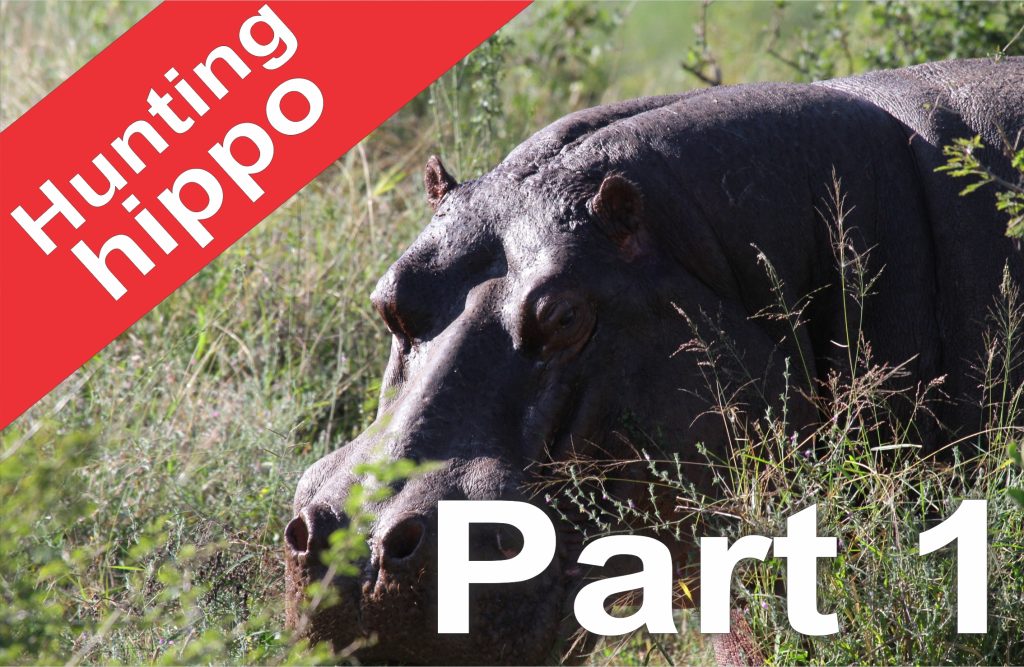Introduction
Hippos may not be regarded as one of the big five but considering the potential danger they pose and the fact that they have killed more people in Africa than any other wild animal – they should be! Don’t fool with hippo you just might end up becoming a statistic. Not many people will get to hunt hippos. The reason is that there are not many people out there who can draw a 90+ pound bow! They are dangerous animals to hunt – especially with bow and arrow.
Hippopotamus called in Afrikaans “seekoei” being literally translated as “sea or river cow” used to be widespread throughout South Africa. Now, they are not as common but can still be found in KwaZulu-Natal, Mpumalanga, and Limpopo province. They have also been reintroduced into the Eastern and Western Cape. They are still quite common in African countries to the north of us where they may be hunted with firearms and archery equipment.
General Description of The Species
Everything about the hippo is big with the exception of its eyes and small rounded ears The head is broad and heavy with the nostrils located on the top of the snout that has valves which seal off the airway when the animals submerge underwater (Figure 1).
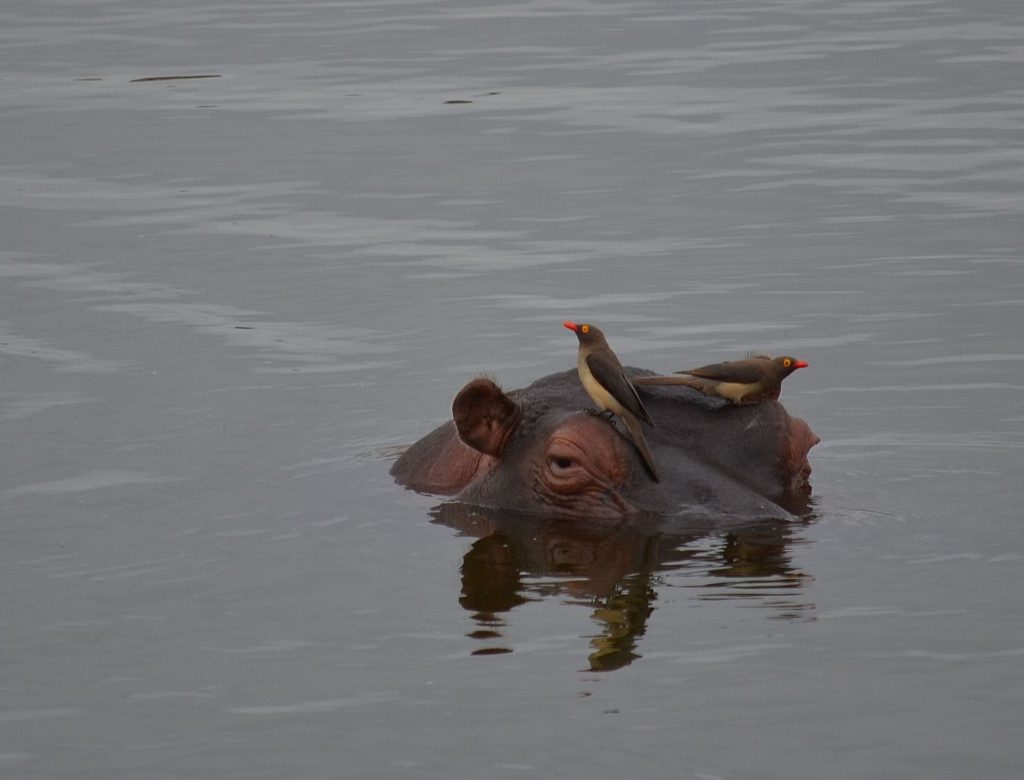
They have short thick, stubby tails. The eyes and nostrils protrude from the face, allowing the animal to see and breathe whilst most of the body is submerged beneath the water. The nostrils are equipped with valves that close shut when the animal submerges. Whenever the animal surfaces after a dive the ears are rapidly rotated to shake off water. They can stay submerged for up to 6 minutes. When resting in the water only the ears, nostrils, and top part of the head are visible.
Except for sparse bristles on the side of the mouth, neck, and tips of the ears, hippos are devoid of body hair. The colour is predominantly a dark grey colour with tinges of purple and pink. When out of the water the animal appears more pink due to a red, slimy, viscous fluid secreted by skin glands. This gave rise to the myth that hippos sweat blood.
Bulls stand about 1, 5 meters (59 inches) tall at the shoulder and weigh in at a whopping 1500 kg on average (3300 pounds), making them one of the largest land mammals. Cows weigh on average 1300 kg or 2860 pounds.
The legs are short but very robust terminating in a four-toed foot.
The broad head has a large mouth sporting large upper and lower incisors which are bared in open-mouth displays as warnings to potential enemies and competitors and used as formidable weapons during serious fights or when attacking (Figure 2). They are also used in self-defence and can bite a medium-sized crocodile in half. Hippo tusks are classed as ivory.

Hippos cannot swim but walk or run on the bottom of the water body. On land or in shallow water they can attain speeds of up to 35 km /h.
Behaviour and Habits
Hippos are water-dependent and will occupy any body of water deep enough to keep themselves covered (Figure 3). They must keep their skin moist to stop it from cracking. They can thus be found in rivers, dams, lakes, swamps, and even farm reservoirs. In times of drought, they will live in shallow water and even mud pools to try and keep themselves wet and cool. They will also be found 10 -12km away from the nearest water – especially during droughts when they are forced to forage far afield.
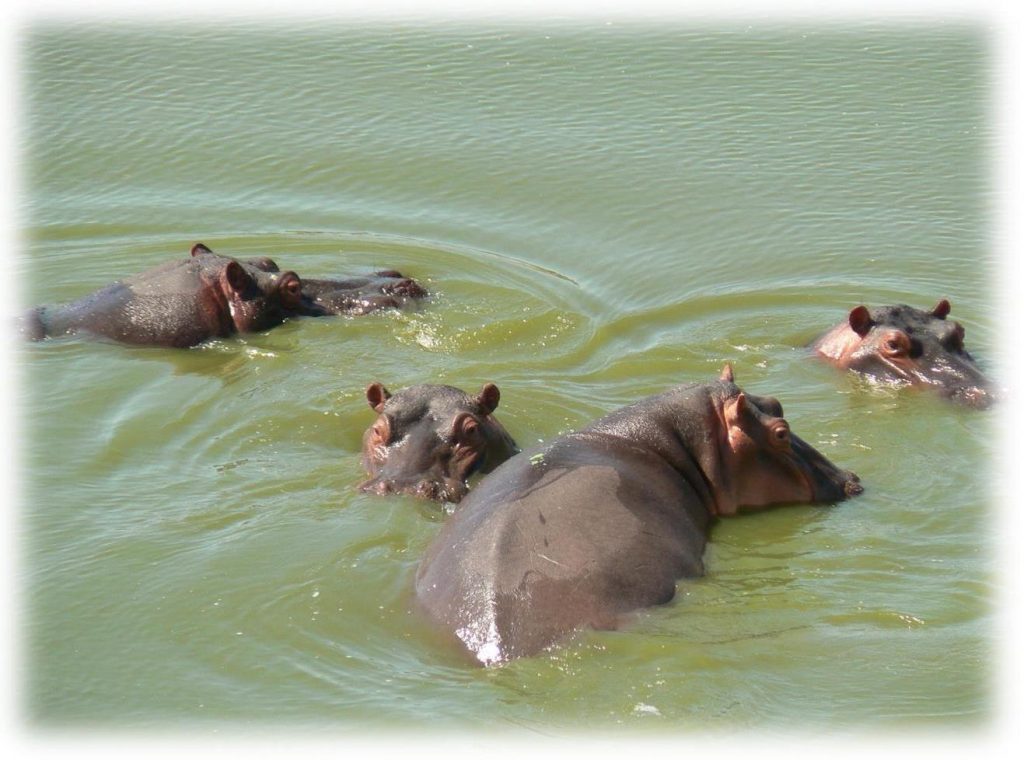
Hippos spend most of the daytime hours in the water with occasional bouts of sunbathing on the river banks – a lifestyle to be envied (Figure 4).

Depending on food availability, they will exit the water to feed soon after sunset and return shortly before daybreak. When there is a shortage of food or they have to walk far to the nearest available grazing, hippos will leave the water earlier and return later than normal. When the food resource is in short supply they will also, on occasion, exit the water to graze on cool and overcast days (Figure 5).
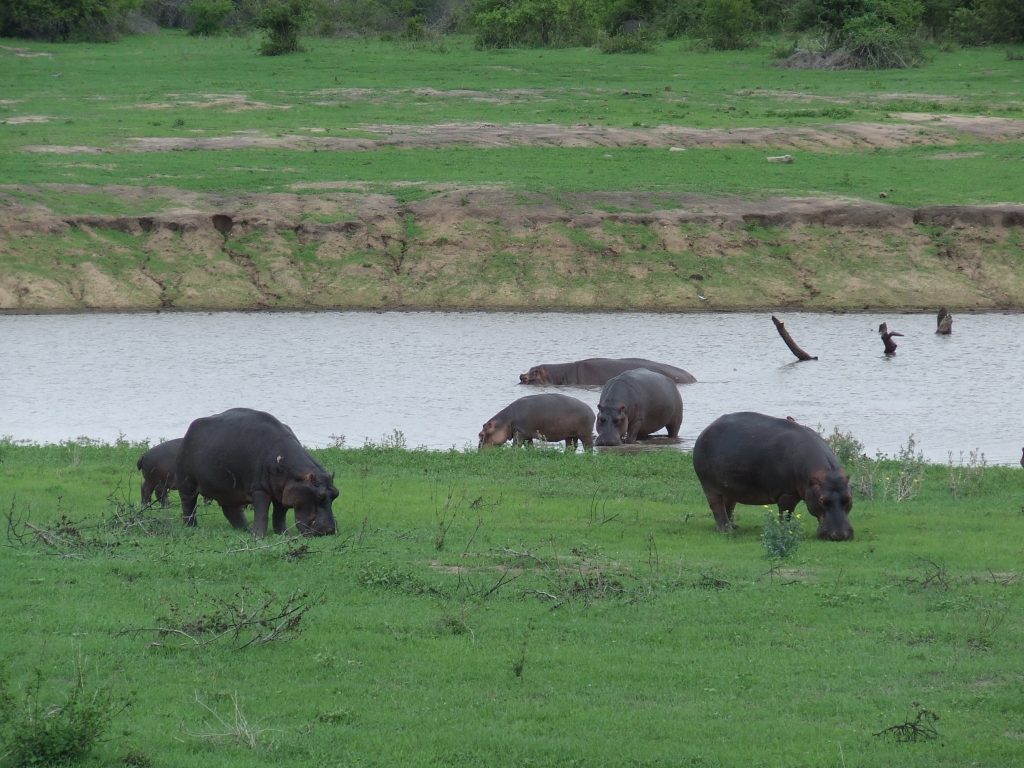
They make use of well-established paths when leaving or returning to the water and if the hunter finds himself on one of these paths in the way of a hippo wanting to return to the water he had better get out of the way in a hurry or run the risk of becoming one of Africa’s statistics.
They are especially dangerous when out of the water.
Hippos, like buffalo, once having initiated a charge, are very likely to carry it through to completion and will only be stopped with a brain shot. They can also be a danger to people standing next to water and will sometimes rush out of the water to attack. Usually, however, they feel safe in the water and will not be overly aggressive to people standing on the shoreline.
Hippos sometimes attack small watercraft and boats. They kill or injure victims by biting. When hippo have young they are intolerant of crocodiles and will chase them off if they approach too closely – often killing them. When there are no young hippos around the adults do not appear to be concerned about the proximity of crocodiles. For all their fearsomeness hippo also have a gentler side to their nature and are known to have come to the assistance of other animals when they have been injured or attacked by crocodiles.
They are very vocal animals and can often be heard “honking” and snorting for no real apparent reason. When one animal vocalizes it usually sets off a honking chain reaction. Hippos are gregarious and can be found in groups of 15 – 20 animals. Large male bulls are sometimes solitary. They have good sight, hearing, and smell and are very silent and stealthy movers on land. Hippos will generally head for the nearest water if disturbed.
They are non-ruminant, single-stomached grazers, feeding primarily on grass and fine reeds. Hippos and farmers are often at loggerheads as hippos are notorious crop raiders and cause a lot of damage to commercial and subsistence farmers. Hippo attacks often occur in crop areas where man and beast happen to meet. Water is essential to their survival and intake is generally passive as it is not actively ingested but taken in as the animal moves around in the water.
Males fight viciously during the rut (Figure 6). Breeding occurs throughout the year. The gestation period is 225 – 257 days and females give birth to a single calf on land. Young suckle both on land and in the water. They travel and rest on the backs of their mothers in the water.
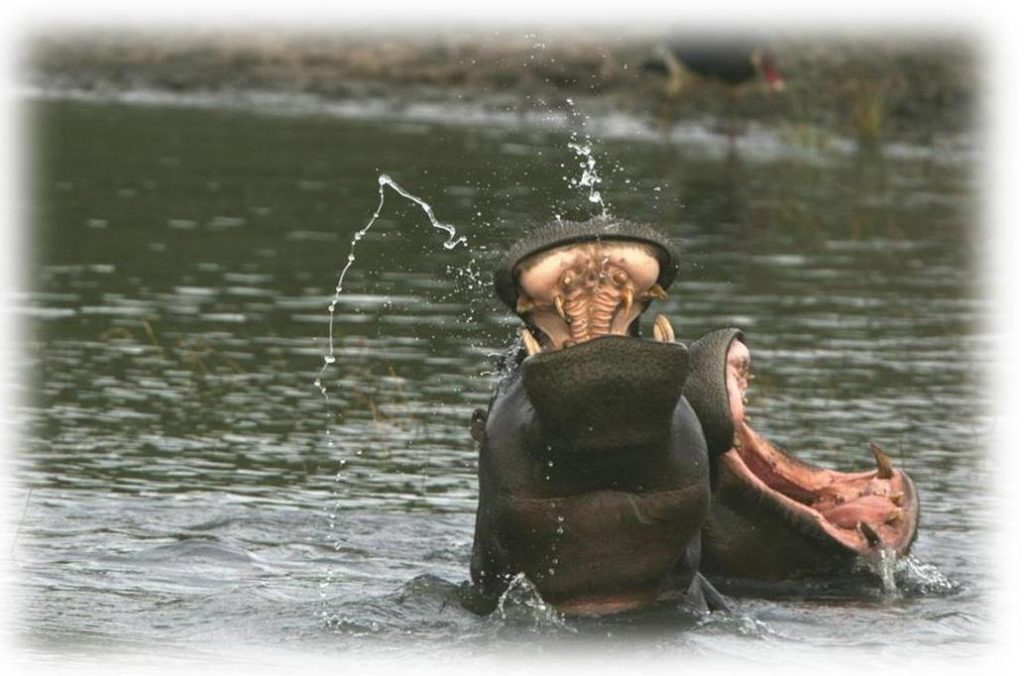
The following behaviour must be regarded as danger signals when in the vicinity of a hippo:
- Staring
- Swimming closer
- Approaching closer when on land
- “Yawning” – opening the mouth wide to display teeth
- Running towards you – generally silent
- Full on charge with open mouth
Hunting the Hippo
Conservation status
The IUCN conservation status of hippos is classified as Lower Risk, of least concern. The global population is estimated to be between 125 000-150 000.
Sign and tracking
- Tracks:
Both front and back feet have four toes. Tracks are about 250mm in length (Figure 7). They make well-worn paths leading to and from their water habitat. The “tramline” path is about 20cm wide – with a distinct “middelmannetjie”.

Scats/droppings:
Hippo dung is large and barrel-shaped (Figure 8). They often break it up whilst defecating by swishing the tail back and forth.

The colour is generally yellowish-green. When dry dung is crushed in the hand it consists of fine, undigested grass material. It is also sprayed and scattered onto bushes in areas they frequent and may be deposited in middens to mark territory (Figure 9).
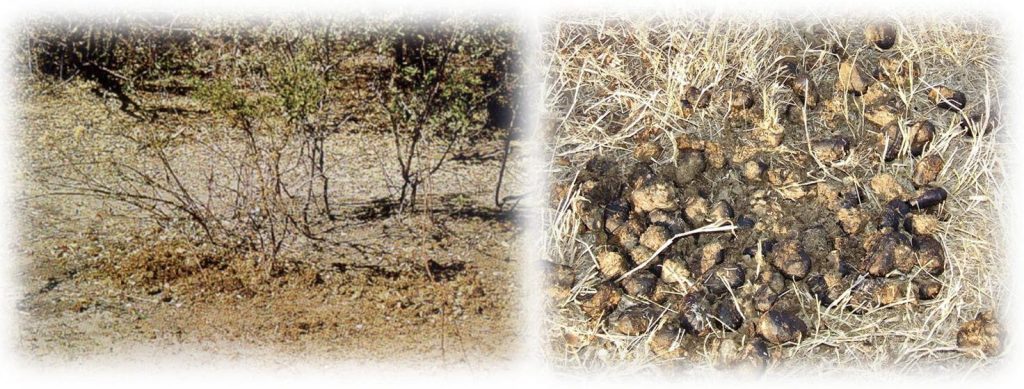
Feeding sign
Grass will be grazed short in areas where hippos have been feeding.
Game paths
They make well-worn paths leading to and from their water habitat.
Sounds
Hippos are very vocal animals and make a range of sounds. Gentle, peaceful honking, snorts, and roars when fighting. They bellow and roar loudly when locked in combat and can be mistaken for lions roaring from a distance.
They are generally very silent animals when out of the water and can move deceptively quietly through the bush despite their immense size. A hunting party must therefore be very observant when walking in areas where hippos are likely to be encountered such as along river banks or close to water. An unexpected meeting with this species can have dire consequences.
Oxpeckers
Red and yellow-billed oxpeckers love sitting on hippos whether they are on land or in the water and may warn you of the presence of a hippo (Figure 10).
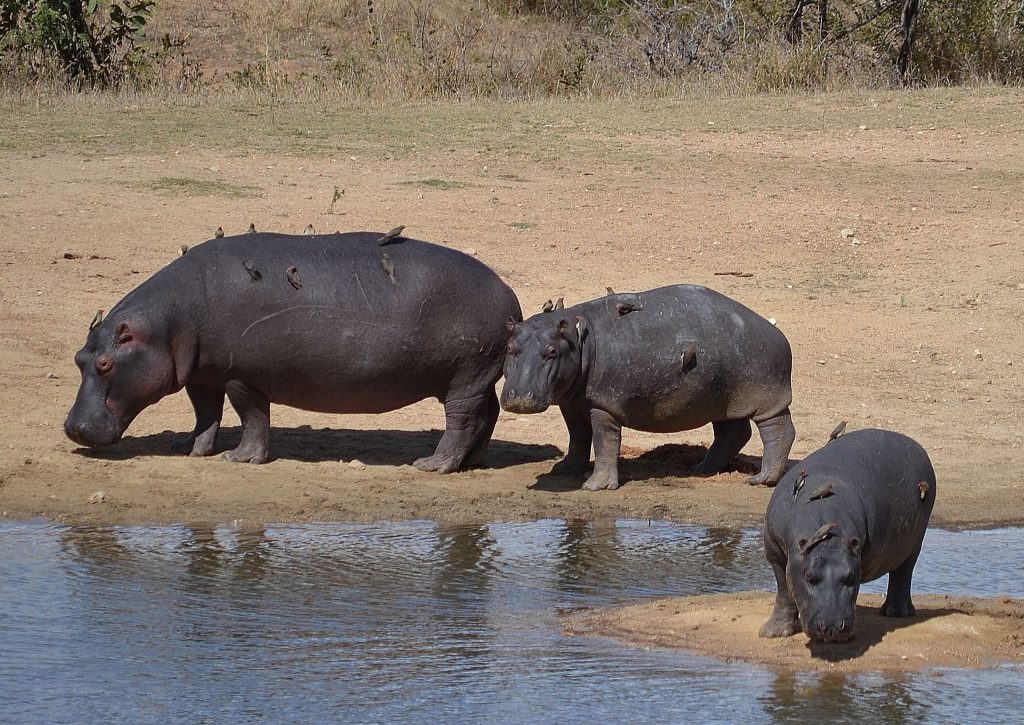
Resting areas
Hippos enjoy basking on riverbanks where tracks and body signs will be evident.
Territorial
Territorial bulls will mark by defecating at preferred spots and also by scattering their droppings against bushes.
Predation, Sickness and Disease
Normal lifespan in the wild is 40 – 50 years.
References
Cheney, C.S. (2013) The Comprehensive Guide to Tracking – Safari Press
Mellon, L. (1975) African Hunter –Harcourt Brace Jovanovich New York and London
Robertson, K. (1999) The Perfect Shot – Safari Press
Robertson, K. (2007) Africa’s Most Dangerous – Safari press

